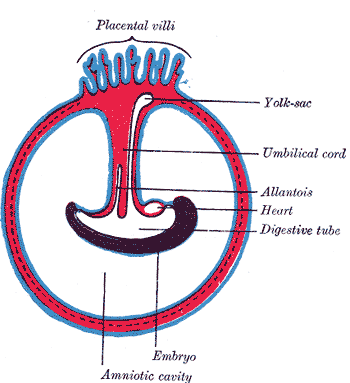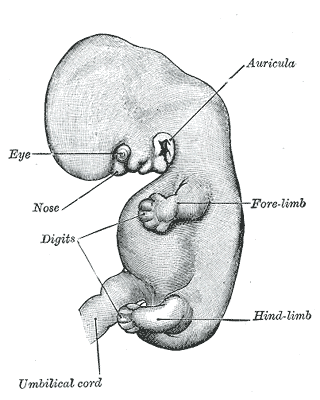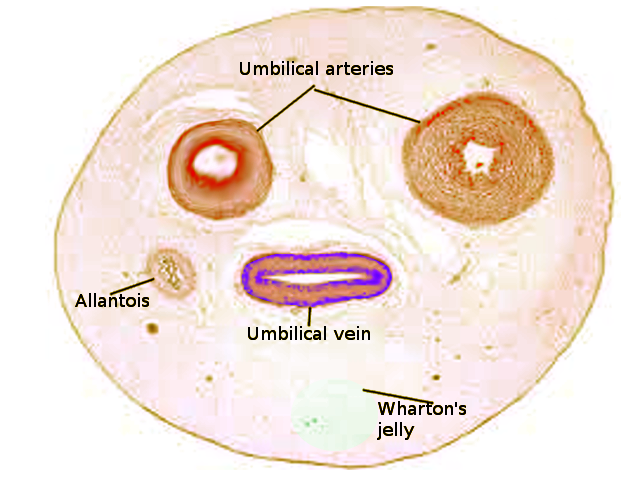[1]
Barrios-Arpi LM, Rodríguez Gutiérrez JL, Lopez-Torres B. Histological characterization of umbilical cord in alpaca (Vicugna pacos). Anatomia, histologia, embryologia. 2017 Dec:46(6):533-538. doi: 10.1111/ahe.12298. Epub 2017 Sep 7
[PubMed PMID: 28884482]
[2]
Tokar B, Yucel F. Anatomical variations of medial umbilical ligament: clinical significance in laparoscopic exploration of children. Pediatric surgery international. 2009 Dec:25(12):1077-80. doi: 10.1007/s00383-009-2467-y. Epub 2009 Aug 30
[PubMed PMID: 19727772]
[3]
Mamatha H, Hemalatha B, Vinodini P, Souza AS, Suhani S. Anatomical Study on the Variations in the Branching Pattern of Internal Iliac Artery. The Indian journal of surgery. 2015 Dec:77(Suppl 2):248-52. doi: 10.1007/s12262-012-0785-0. Epub 2012 Dec 20
[PubMed PMID: 26730003]
[4]
Hooper SB, Polglase GR, te Pas AB. A physiological approach to the timing of umbilical cord clamping at birth. Archives of disease in childhood. Fetal and neonatal edition. 2015 Jul:100(4):F355-60. doi: 10.1136/archdischild-2013-305703. Epub 2014 Dec 24
[PubMed PMID: 25540147]
[5]
Di Naro E, Ghezzi F, Raio L, Franchi M, D'Addario V. Umbilical cord morphology and pregnancy outcome. European journal of obstetrics, gynecology, and reproductive biology. 2001 Jun:96(2):150-7
[PubMed PMID: 11384798]
[6]
Fathi AH, Soltanian H, Saber AA. Surgical anatomy and morphologic variations of umbilical structures. The American surgeon. 2012 May:78(5):540-4
[PubMed PMID: 22546125]
[7]
Parada Villavicencio C, Adam SZ, Nikolaidis P, Yaghmai V, Miller FH. Imaging of the Urachus: Anomalies, Complications, and Mimics. Radiographics : a review publication of the Radiological Society of North America, Inc. 2016 Nov-Dec:36(7):2049-2063
[PubMed PMID: 27831842]
[8]
Umeda S, Usui N, Kanagawa T, Yamamichi T, Nara K, Ueno T, Owari M, Uehara S, Oue T, Kimura T, Okuyama H. Prenatal and Postnatal Clinical Course of an Urachus Identified as an Allantoic Cyst in the Umbilical Cord. European journal of pediatric surgery : official journal of Austrian Association of Pediatric Surgery ... [et al] = Zeitschrift fur Kinderchirurgie. 2016 Apr:26(2):200-2. doi: 10.1055/s-0035-1549263. Epub 2016 Mar 16
[PubMed PMID: 26981767]
[9]
Ullberg U, Sandstedt B, Lingman G. Hyrtl's anastomosis, the only connection between the two umbilical arteries. A study in full term placentas from AGA infants with normal umbilical artery blood flow. Acta obstetricia et gynecologica Scandinavica. 2001 Jan:80(1):1-6
[PubMed PMID: 11167180]
[10]
Ullberg U, Lingman G, Ekman-Ordeberg G, Sandstedt B. Hyrtl's anastomosis is normally developed in placentas from small for gestational age infants. Acta obstetricia et gynecologica Scandinavica. 2003 Aug:82(8):716-21
[PubMed PMID: 12848642]
[11]
Coetzee AJ, Castro E, Peres LC. Umbilical Cord Coiling and Zygosity: Is there a Link? Fetal and pediatric pathology. 2015:34(5):336-9. doi: 10.3109/15513815.2015.1075634. Epub 2015 Aug 20
[PubMed PMID: 26291249]
[12]
Hubbard LJ, Stanford DA. The Umbilical Cord Lifeline. Journal of emergency nursing. 2017 Nov:43(6):593-595. doi: 10.1016/j.jen.2017.07.010. Epub
[PubMed PMID: 29100578]
[14]
Strong A, Gračner T, Chen P, Kapinos K. On the Value of the Umbilical Cord Blood Supply. Value in health : the journal of the International Society for Pharmacoeconomics and Outcomes Research. 2018 Sep:21(9):1077-1082. doi: 10.1016/j.jval.2018.03.003. Epub 2018 Apr 12
[PubMed PMID: 30224112]
[15]
Jin ZW, Nakamura T, Yu HC, Kimura W, Murakami G, Cho BH. Fetal anatomy of peripheral lymphatic vessels: a D2-40 immunohistochemical study using an 18-week human fetus (CRL 155 mm). Journal of anatomy. 2010 Jun:216(6):671-82. doi: 10.1111/j.1469-7580.2010.01229.x. Epub 2010 Apr 7
[PubMed PMID: 20408907]
[16]
Marx GF, Joshi CW, Orkin LR. Placental transmission of nitrous oxide. Anesthesiology. 1970 May:32(5):429-32
[PubMed PMID: 5445031]
[17]
DeFreitas MJ, Mathur D, Seeherunvong W, Cano T, Katsoufis CP, Duara S, Yasin S, Zilleruelo G, Rodriguez MM, Abitbol CL. Umbilical artery histomorphometry: a link between the intrauterine environment and kidney development. Journal of developmental origins of health and disease. 2017 Jun:8(3):349-356. doi: 10.1017/S2040174417000113. Epub 2017 Mar 6
[PubMed PMID: 28260559]
[18]
Hardy KJ, Nye DH. The anatomy of the umbilical vein. The Australian and New Zealand journal of surgery. 1969 Nov:39(2):127-32
[PubMed PMID: 5264514]
[19]
Baudin B, Bruneel A, Bosselut N, Vaubourdolle M. A protocol for isolation and culture of human umbilical vein endothelial cells. Nature protocols. 2007:2(3):481-5
[PubMed PMID: 17406610]
[20]
Kashanian M, Akbarian A, Kouhpayehzadeh J. The umbilical coiling index and adverse perinatal outcome. International journal of gynaecology and obstetrics: the official organ of the International Federation of Gynaecology and Obstetrics. 2006 Oct:95(1):8-13
[PubMed PMID: 16860802]
[21]
Ernst LM, Minturn L, Huang MH, Curry E, Su EJ. Gross patterns of umbilical cord coiling: correlations with placental histology and stillbirth. Placenta. 2013 Jul:34(7):583-8. doi: 10.1016/j.placenta.2013.04.002. Epub 2013 May 2
[PubMed PMID: 23642640]
[22]
Feliks M, Howorka E. [Functional value of false knots of the umbilical cord]. Ginekologia polska. 1968 Jun:39(6):617-24
[PubMed PMID: 5675023]
[23]
Lubusky M, Dhaifalah I, Prochazka M, Hyjanek J, Mickova I, Vomackova K, Santavy J. Single umbilical artery and its siding in the second trimester of pregnancy: relation to chromosomal defects. Prenatal diagnosis. 2007 Apr:27(4):327-31
[PubMed PMID: 17286313]
[24]
Geipel A, Germer U, Welp T, Schwinger E, Gembruch U. Prenatal diagnosis of single umbilical artery: determination of the absent side, associated anomalies, Doppler findings and perinatal outcome. Ultrasound in obstetrics & gynecology : the official journal of the International Society of Ultrasound in Obstetrics and Gynecology. 2000 Feb:15(2):114-7
[PubMed PMID: 10775992]
[25]
Blazer S, Sujov P, Escholi Z, Itai BH, Bronshtein M. Single umbilical artery--right or left? does it matter? Prenatal diagnosis. 1997 Jan:17(1):5-8
[PubMed PMID: 9021822]
[26]
Budorick NE, Kelly TF, Dunn JA, Scioscia AL. The single umbilical artery in a high-risk patient population: what should be offered? Journal of ultrasound in medicine : official journal of the American Institute of Ultrasound in Medicine. 2001 Jun:20(6):619-27; quiz 628
[PubMed PMID: 11400936]
[27]
Abuhamad AZ, Shaffer W, Mari G, Copel JA, Hobbins JC, Evans AT. Single umbilical artery: does it matter which artery is missing? American journal of obstetrics and gynecology. 1995 Sep:173(3 Pt 1):728-32
[PubMed PMID: 7573234]
[28]
Sepulveda W, Peek MJ, Hassan J, Hollingsworth J. Umbilical vein to artery ratio in fetuses with single umbilical artery. Ultrasound in obstetrics & gynecology : the official journal of the International Society of Ultrasound in Obstetrics and Gynecology. 1996 Jul:8(1):23-6
[PubMed PMID: 8843614]
[29]
Hoagland MA, Chatterjee D. Anesthesia for fetal surgery. Paediatric anaesthesia. 2017 Apr:27(4):346-357. doi: 10.1111/pan.13109. Epub 2017 Feb 17
[PubMed PMID: 28211140]
[30]
Tomek S, Asch S. Umbilical vein catheterization in the critical newborn: a review of anatomy and technique. EMS world. 2013 Feb:42(2):50-2
[PubMed PMID: 23469464]
[32]
Shevell T, Malone FD, Vidaver J, Porter TF, Luthy DA, Comstock CH, Hankins GD, Eddleman K, Dolan S, Dugoff L, Craigo S, Timor IE, Carr SR, Wolfe HM, Bianchi DW, D'Alton ME. Assisted reproductive technology and pregnancy outcome. Obstetrics and gynecology. 2005 Nov:106(5 Pt 1):1039-45
[PubMed PMID: 16260523]
[33]
Yanaihara A, Hatakeyama S, Ohgi S, Motomura K, Taniguchi R, Hirano A, Takenaka S, Yanaihara T. Difference in the size of the placenta and umbilical cord between women with natural pregnancy and those with IVF pregnancy. Journal of assisted reproduction and genetics. 2018 Mar:35(3):431-434. doi: 10.1007/s10815-017-1084-2. Epub 2017 Nov 14
[PubMed PMID: 29134477]
[34]
Painter D, Russell P. Four-vessel umbilical cord associated with multiple congenital anomalies. Obstetrics and gynecology. 1977 Oct:50(4):505-7
[PubMed PMID: 904818]
[35]
Kim JH, Jin ZW, Murakami G, Chai OH, Rodríguez-Vázquez JF. Persistent right umbilical vein: a study using serial sections of human embryos and fetuses. Anatomy & cell biology. 2018 Sep:51(3):218-222. doi: 10.5115/acb.2018.51.3.218. Epub 2018 Sep 28
[PubMed PMID: 30310717]
[36]
Sepulveda W, Shennan AH, Bower S, Nicolaidis P, Fisk NM. True knot of the umbilical cord: a difficult prenatal ultrasonographic diagnosis. Ultrasound in obstetrics & gynecology : the official journal of the International Society of Ultrasound in Obstetrics and Gynecology. 1995 Feb:5(2):106-8
[PubMed PMID: 7719859]
[37]
Olaya-C M, Bernal JE. Clinical associations to abnormal umbilical cord length in Latin American newborns. Journal of neonatal-perinatal medicine. 2015:8(3):251-6. doi: 10.3233/NPM-15915056. Epub
[PubMed PMID: 26485559]
[39]
Hoopmann M, Kagan KO. Abnormal Placentation and Umbilical Cord Insertion. Ultraschall in der Medizin (Stuttgart, Germany : 1980). 2020 Apr:41(2):120-137. doi: 10.1055/a-1079-0013. Epub 2020 Apr 7
[PubMed PMID: 32259863]
[40]
Muniraman H, Sardesai T, Sardesai S. Disorders of the Umbilical Cord. Pediatrics in review. 2018 Jul:39(7):332-341. doi: 10.1542/pir.2017-0202. Epub
[PubMed PMID: 29967078]
[41]
Hannaford K, Reeves S, Wegner E. Umbilical cord cysts in the first trimester: are they associated with pregnancy complications? Journal of ultrasound in medicine : official journal of the American Institute of Ultrasound in Medicine. 2013 May:32(5):801-6. doi: 10.7863/ultra.32.5.801. Epub
[PubMed PMID: 23620322]
[42]
Whipple NS, Bennett EE, Kaza E, O'Connor M. Umbilical Cord Pseudocyst in a Newborn. The Journal of pediatrics. 2016 Oct:177():333. doi: 10.1016/j.jpeds.2016.06.060. Epub 2016 Jul 26
[PubMed PMID: 27473880]
[43]
Ancer-Arellano J, Argenziano G, Villarreal-Martinez A, Cardenas-de la Garza JA, Villarreal-Villarreal CD, Ocampo-Candiani J. Dermoscopic findings of umbilical granuloma. Pediatric dermatology. 2019 May:36(3):393-394. doi: 10.1111/pde.13774. Epub 2019 Feb 27
[PubMed PMID: 30811653]




